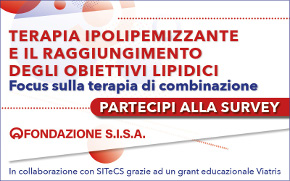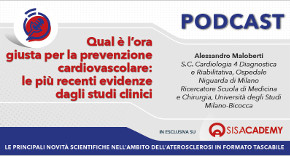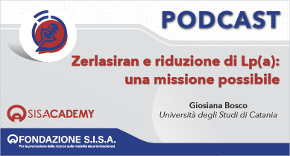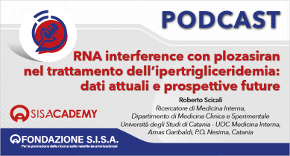 Rivista in lingua italiana
Rivista in lingua italiana
riservata ai Soci SISA
Ultimo numero:
Anno 16 • N.1/2025
Abstract
Association of LDL cholesterol, non-HDL cholesterol, and apolipoprotein B levels with risk of cardiovascular events among patients treated with statins: a meta-analysis.
Boekholdt SM, Arsenault BJ, Mora S, Pedersen TR, LaRosa JC, Nestel PJ, Simes RJ, Durrington P, Hitman GA, Welch KM, DeMicco DA, Zwinderman AH, Clearfield MB, Downs JR, Tonkin AM, Colhoun HM, Gotto AM Jr, Ridker PM, Kastelein JJ.
JAMA 2012;307:1302-9
OBJECTIVE: To evaluate the relative strength of the associations of LDL-C, non-HDL-C, and apoB with cardiovascular risk among patients treated with statin therapy.
DESIGN: Meta-analysis of individual patient data from randomized controlled statin trials in which conventional lipids and apolipoproteins were determined in all study participants at baseline and at 1-year follow-up.
DATA SOURCES: Relevant trials were identified by a literature search updated through December 31, 2011. Investigators were contacted and individual patient data were requested and obtained for 62,154 patients enrolled in 8 trials published between 1994 and 2008.
DATA EXTRACTION: Hazard ratios (HRs) and corresponding 95% CIs for risk of major cardiovascular events adjusted for established risk factors by 1-SD increase in LDL-C, non-HDL-C, and apoB.
RESULTS: Among 38,153 patients allocated to statin therapy, 158 fatal myocardial infarctions, 1678 nonfatal myocardial infarctions, 615 fatal events from other coronary artery disease, 2806 hospitalizations for unstable angina, and 1029 fatal or nonfatal strokes occurred during follow-up. The adjusted HRs for major cardiovascular events per 1-SD increase were 1.13 (95% CI, 1.10-1.17) for LDL-C, 1.16 (95% CI, 1.12-1.19) for non-HDL-C, and 1.14 (95% CI, 1.11-1.18) for apoB. These HRs were significantly higher for non-HDL-C than LDL-C (P = .002) and apoB (P = .02). There was no significant difference between apoB and LDL-C (P = .21).
CONCLUSION: Among statin-treated patients, on-treatment levels of LDL-C, non-HDL-C, and apoB were each associated with risk of future major cardiovascular events, but the strength of this association was greater for non-HDL-C than for LDL-C and apoB.

Area Soci
Eventi
39° Congresso Nazionale
 39° Congresso Nazionale
39° Congresso NazionaleRoma, 23-25 novembre 2025
Save the date




 Spring Meeting Gruppi Giovani SID, SIGG, SIIA, SIMI, SIPREC, SISA
Spring Meeting Gruppi Giovani SID, SIGG, SIIA, SIMI, SIPREC, SISARimini, 6-8 aprile 2025
[continua a leggere]
 SISA LIPID ACADEMY - Corso avanzato di lipidologia clinica
SISA LIPID ACADEMY - Corso avanzato di lipidologia clinicaModena, 4-5 Luglio 2024
[continua a leggere]Giornale Italiano Arteriosclerosi
HoFH today
 Rivista Italiana della
Rivista Italiana della
Ipercolesterolemia
Familiare Omozigote
Anno 6 • N.1/2024
Rivista NMCD
Diateca
[continua a leggere]
[continua a leggere]
Newsletter
il vostro indirizzo di posta elettronica
Progetto LIPIGEN

Nuovo sito dedicato al Progetto LIPIGEN
Progetto LIPIGEN - Vecchio portale
E' necessario essere loggati come utente
Lipigen per poter accedere alla pagina
PROject Statin Intolerance SISA
PROSISA – PROject Statin Intolerance SISA
E' necessario essere loggati come utente
PROSISA per poter accedere alla pagina
GILA - Lipoprotein Aferesi
Gruppo Interdisciplinare Lipoprotein Aferesi
(Accesso Gruppo GILA-Lipoprotein Aferesi)
E' necessario essere loggati come utente del Gruppo GILA per poter accedere
Gruppo Interdisciplinare Lipoprotein Aferesi
(Documentazione ad accesso libero)
Pagina informativa per medici e pazienti










